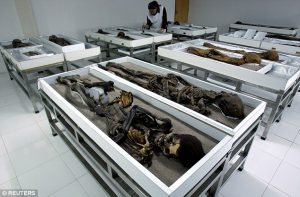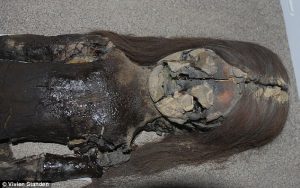The Chinchorro mummies, being world oldest ones, buried more than 7000 years ago in northern Chile are being turned into black slime, due to bacteria thriving on the preserved skin. Chilean researchers blame climate changes and ask for aid in their fight for preservation of the mummified human remains.

Nearly 300 mummies were recovered in recent years at the coastal area near the border with Peru in northern Chile. These remains, belonging to the Chinchorro people, a prehistoric society who lived 5000 years ago on the desert coast of Chile and Peru, are the world’s oldest mummies, due to burials having been made in extremely dry conditions. The mummies need to be kept in specific conditions of temperature and humidity to prevent deterioration as humidity causes an explosion of bacteria living on the preserved skin of the Chinchorro mummies. Once developed a colony of bacteria causes the ancient skin to break down into a black slime.

Researchers from the University of Tarapacá in the city of Arica state that climate change causes humidity levels to rise in the area, putting 120 Chinchorro mummies kept at University of Tarapacá at risk. An estimated number of 282 mummies have now been recovered from the dry, sandy soil in the region but the experts speculate that there could be hundreds more buried there.

Arica and the surrounding Atacama Desert is one of the driest places in the world. The mummies are often found as the shifting sand exposes their bodies. But the region has been growing slowly damper in recent years. Since the initial find of the first changes in form of black spots on the preserved skin of the Chinchorro mummies around ten years ago, hey have degraded at an alarming rate as the preserved skin has broken down into a black slime. Researchers at Harvard School of Engineering and Applied Sciences found out that the bacteria growing on the human skin appeared to become “supercharged” when placed on mummy skin in high humidity and the mummies need to be kept at between 40 per cent and 60 per cent humidity to prevent degradation.
Sergio Medina Parra, anthropologist and department head at University of Tarapacá is leading an attempt to get the Chinchorro mummies recognised by UN heritage body UNESCO as a world heritage site and start a process of applying improved conservation tools, with the Chilean state and the international community in order to preserve the mummies.
(after Daily Mail)